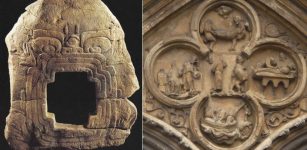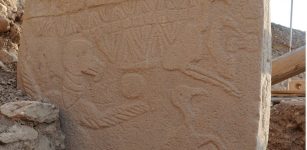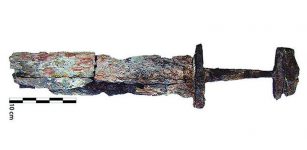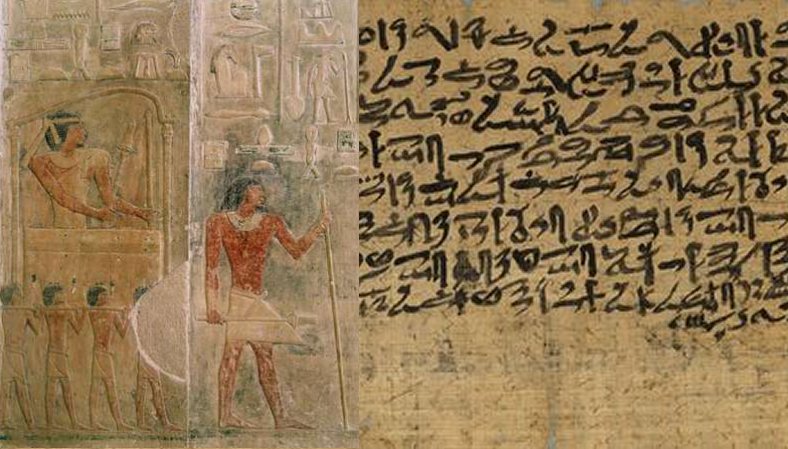Secrets Of Maxims Of Ptahhotep – Ancient Egyptian Wisdom Is Still Relevant Today
Ellen Lloyd - AncientPages.com - The history of ancient Egypt may sometimes seem very distant, but people living thousands of years ago had many problems and feelings that trouble us today.
During the Fifth Dynasty (2,500 B.C. – 2,350 B.C), Egyptian Vizier Ptahhotep, occasionally known as Ptahhotep I, Ptahhotpe or Ptah-Hotep wrote several instructions based on his wisdom and experiences.
His precious text contains advice on how to live your life, and much of what he wrote is still highly relevant today.
The Maxims of Ptahhotep influenced later philosophical works, and his work is one of the first Egyptian books.
Left: Ptahhotep on a palanquin, relief from his tomb. Werner-Forman Archive/Heritage-Images - Right: The Maxims of Ptahhotep, Public Domain
This precious ancient text was discovered in Thebes in 1847 by Egyptologist M. Prisse d’Avennes. There are four copies of the Instructions, and the only complete version, Papyrus Prisse, is located in the Bibliothèque Nationale in Paris.
Vizier Ptahhotep’s wisdom literature was basically a set of moral advice and proverbs for young men. Ptahhotep was a very intelligent man who was the city administrator and vizier (first minister) during the reign of Djedkare Isesi. He had a son named Akhethotep, who was also a vizier. He and his descendants were buried at Saqqara.
His grandson Ptahhotep Tshefi's writings were collected from his grandfather’s texts that were written using hieratic writing, that is, a simplification of the hieroglyphic writing used by the scribes to write on papyri.
In his writings, Ptahhotep reveals that he has dedicated his long life to obtaining wisdom, which can never be completely achieved.
Then the book is spelled out in a series of brief tips that are grouped into 37 topics. In his introduction, reminded us that knowledge is endless. "Do not be arrogant because of your knowledge, but confer with the ignorant man as with the learned. For knowledge has no limits, and none has yet achieved perfection in it."
Originally published as "The Instruction of Ptah-Hotep" and also as "The Maxims of Ptahhotep," the work is believed by some scholars to be the oldest book in the world. Authorship is attributed to Ptahhotep, a vizier under King Isesi of the Egyptian Fifth Dynasty (ca. 2414-2375 BC). It is a collection of maxims and advice in the sebayt ("teaching") genre on human relations and are provided as instruction for his son. The work survives today in papyrus copies, including the Prisse Papyrus which dates from the Middle Kingdom and is on display at the Bibliothèque Nationale in Paris. There are considerable differences between the Prisse Papyrus version and the two texts at the British Museum. The 1906 translation by Battiscombe Gunn, published as part of the "Wisdom of the East" series and which is reprinted here, was made directly from the Prisse Papyrus, in Paris, rather than from copies. Some lessons include: Learning by listening to everybody and knowing that human knowledge is never perfect are a leitmotif. Avoiding open conflict wherever possible should not be considered weakness. Justice should be pursued and in the end it will be a god's command that prevails. Greed is the base of all evil and should be guarded against, while generosity towards family and friends is praiseworthy. Read more
Ptahhotep also advises against listening to rumors and spreading slander. Maxim no. 21 states: "Do not repeat slander; you should not hear it, for it is the result of hot temper."
From Maxim no. 34, we learn that Ptahhotep was a man of peace rather than war. He advised: "Be a craftsman in speech that thou mayest be strong, for the strength of one is the tongue, and speech is mightier than all fighting."
There are naturally many more examples of guidance, and anyone interested in ancient Egyptian wisdom may find his thoughts interesting. His wisdom quotes are collected in The Teachings of Ptahhotep: The Oldest Book in the World.
Ptahhotep rests in the mastaba designated D64. His tomb is famous for its outstanding depictions.
The reliefs in the tomb chamber are the best preserved in the Old Kingdom.
Updated on October 13, 2024
Written by Ellen Lloyd – AncientPages.com
Copyright © AncientPages.com All rights reserved. This material may not be published, broadcast, rewritten or redistributed in whole or part without the express written permission of AncientPages.com
Expand for referencesMore From Ancient Pages
-
 1.8-Million-Year-Old Human Tooth Found In Georgia Offers More Information On Prehistoric Human Migrations
Archaeology | Sep 15, 2022
1.8-Million-Year-Old Human Tooth Found In Georgia Offers More Information On Prehistoric Human Migrations
Archaeology | Sep 15, 2022 -
 Why Was The Face Of Mysterious Ust-Taseyevsky Stone Idol Suddenly Changed?
Archaeology | Jan 18, 2021
Why Was The Face Of Mysterious Ust-Taseyevsky Stone Idol Suddenly Changed?
Archaeology | Jan 18, 2021 -
 Ancient Andean People Had A Plant-Based Diet And Were Not Hunter-Gatherers
Archaeology | Jan 25, 2024
Ancient Andean People Had A Plant-Based Diet And Were Not Hunter-Gatherers
Archaeology | Jan 25, 2024 -
 How Did Vikings Celebrate Yule – The Winter Solstice?
Christmas Traditions | Dec 21, 2024
How Did Vikings Celebrate Yule – The Winter Solstice?
Christmas Traditions | Dec 21, 2024 -
 Why Have So Few Who Have Seen This Mysterious Victorian-Era Entity Survived?
Featured Stories | Sep 8, 2024
Why Have So Few Who Have Seen This Mysterious Victorian-Era Entity Survived?
Featured Stories | Sep 8, 2024 -
 Rare Medieval Tattoo Depicting A Christogram Unearthed In Ghazali, Sudan
Archaeology | Nov 9, 2023
Rare Medieval Tattoo Depicting A Christogram Unearthed In Ghazali, Sudan
Archaeology | Nov 9, 2023 -
 Quatrefoil Symbol Was Used By The Olmecs And Maya Long Before It Appeared On Christians Churches
Ancient Symbols | Mar 19, 2018
Quatrefoil Symbol Was Used By The Olmecs And Maya Long Before It Appeared On Christians Churches
Ancient Symbols | Mar 19, 2018 -
 Evidence Of Neolithic Bird Hunting In Upper Mesopotamia
Archaeology | Sep 27, 2023
Evidence Of Neolithic Bird Hunting In Upper Mesopotamia
Archaeology | Sep 27, 2023 -
 Lincolnshire’s Prehistoric Henge And A Sacred Site Dating Back Hundreds Of Years
Archaeology | Apr 6, 2024
Lincolnshire’s Prehistoric Henge And A Sacred Site Dating Back Hundreds Of Years
Archaeology | Apr 6, 2024 -
 Hidden Byzantine Hoard Offers Evidence Of A Dramatic Historial Event In The Levant
Artifacts | Oct 13, 2022
Hidden Byzantine Hoard Offers Evidence Of A Dramatic Historial Event In The Levant
Artifacts | Oct 13, 2022 -
 Why Did A Solar Eclipse Save George Davidson’s Life In Alaska?
Ancient History Facts | Aug 23, 2024
Why Did A Solar Eclipse Save George Davidson’s Life In Alaska?
Ancient History Facts | Aug 23, 2024 -
 8,000-Year-Old House Remains Discovered In Svinjarička Čuka, Serbia Raise Questions About Europe’s First Farmers
Archaeology | Oct 21, 2024
8,000-Year-Old House Remains Discovered In Svinjarička Čuka, Serbia Raise Questions About Europe’s First Farmers
Archaeology | Oct 21, 2024 -
 Suprising Discovery Of A Well-Preserved Ancient Roman Road In London, UK
Archaeology | Nov 19, 2024
Suprising Discovery Of A Well-Preserved Ancient Roman Road In London, UK
Archaeology | Nov 19, 2024 -
 Giants Did Exist And Were A Part Of Earth’s Ancient History
Ancient Mysteries | Apr 29, 2014
Giants Did Exist And Were A Part Of Earth’s Ancient History
Ancient Mysteries | Apr 29, 2014 -
 Viking Sword Found In Patara May Have Belonged To A Varangian Guard
Archaeology | Nov 22, 2018
Viking Sword Found In Patara May Have Belonged To A Varangian Guard
Archaeology | Nov 22, 2018 -
 On This Day In History: Sir Thomas Brisbane, Astronomer, Soldier And Governor Was Born – On July 23, 1773
News | Jul 23, 2016
On This Day In History: Sir Thomas Brisbane, Astronomer, Soldier And Governor Was Born – On July 23, 1773
News | Jul 23, 2016 -
 Mystery Of An ‘Impossible’ Event In Georgia Linked To An Unusual Woman
Featured Stories | May 15, 2024
Mystery Of An ‘Impossible’ Event In Georgia Linked To An Unusual Woman
Featured Stories | May 15, 2024 -
 Gods’ Creation Of Five Different Human Races – Ages Of Man On The Earth And The End Of The World
Featured Stories | Jan 26, 2018
Gods’ Creation Of Five Different Human Races – Ages Of Man On The Earth And The End Of The World
Featured Stories | Jan 26, 2018 -
 New Insight Into Genetic History And Social Structures In Neolithic And Bronze Age Croatia
Archaeology | Aug 18, 2021
New Insight Into Genetic History And Social Structures In Neolithic And Bronze Age Croatia
Archaeology | Aug 18, 2021 -
 Famous Viking Sigurd Snake-In-The-Eye, Son Of Ragnar Lodbrok And The Mark Of Fafnir Prophecy
Featured Stories | Mar 16, 2018
Famous Viking Sigurd Snake-In-The-Eye, Son Of Ragnar Lodbrok And The Mark Of Fafnir Prophecy
Featured Stories | Mar 16, 2018


